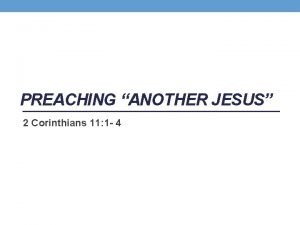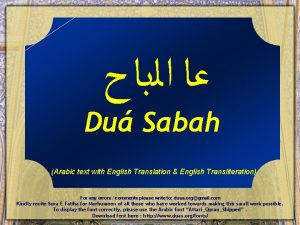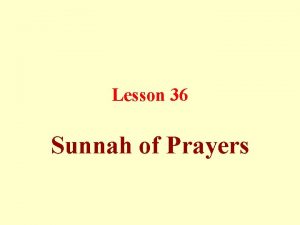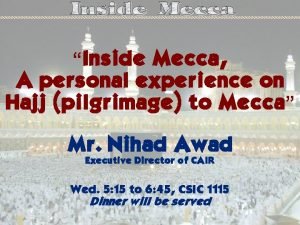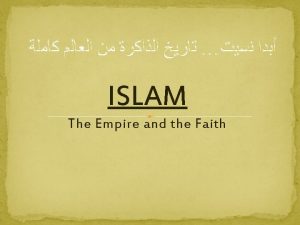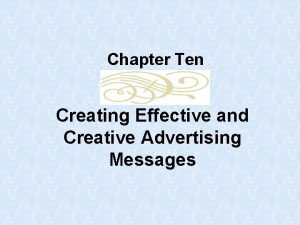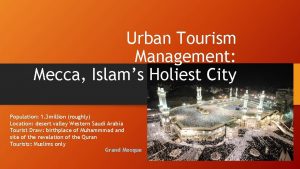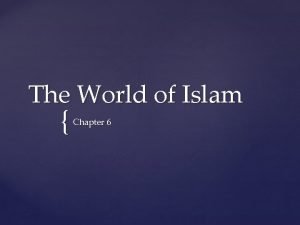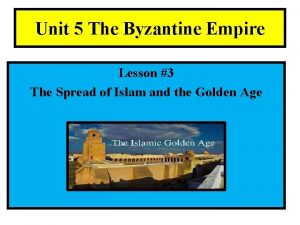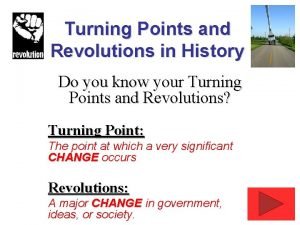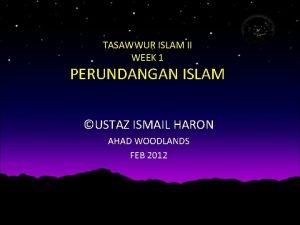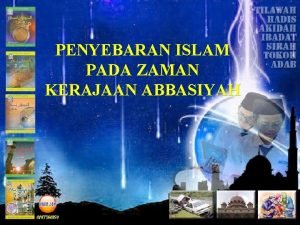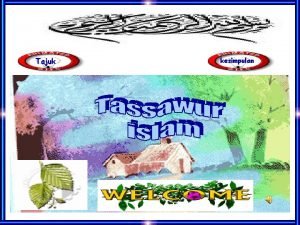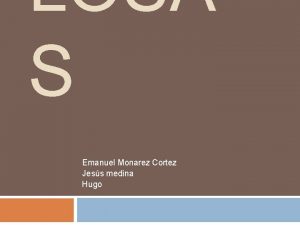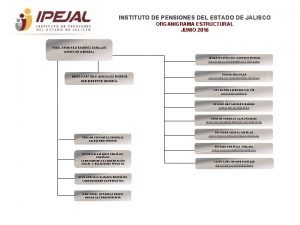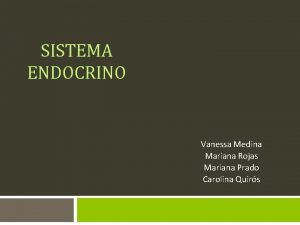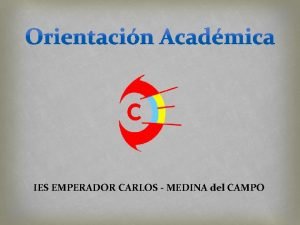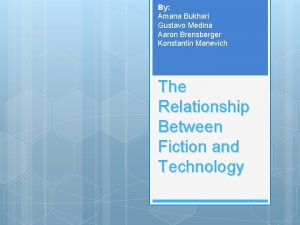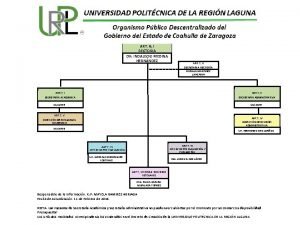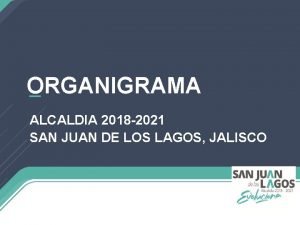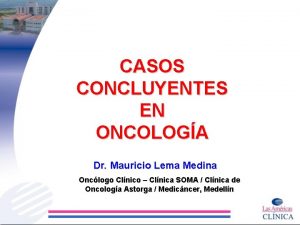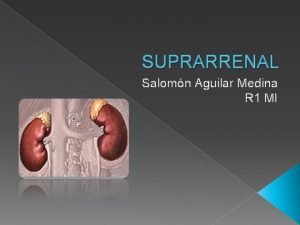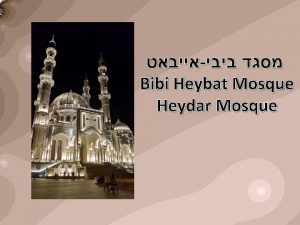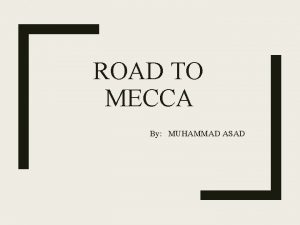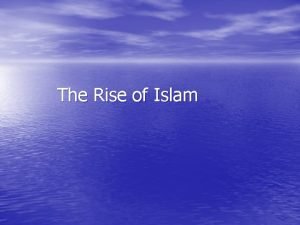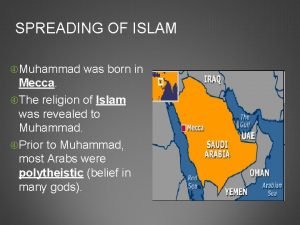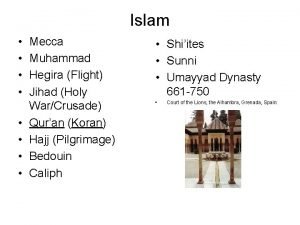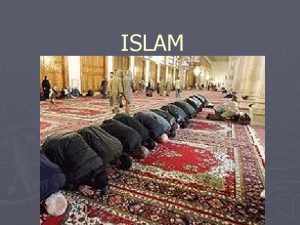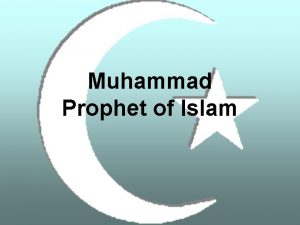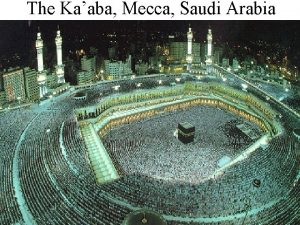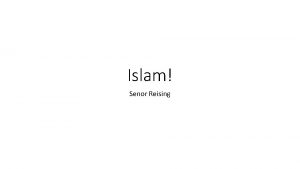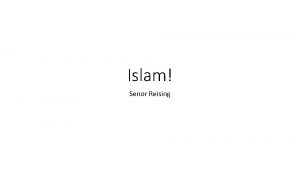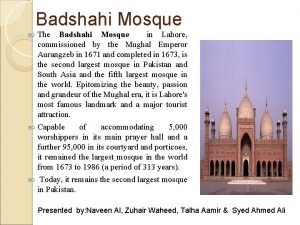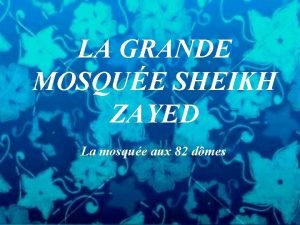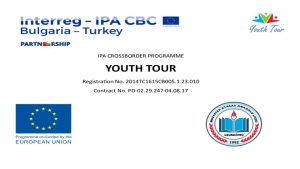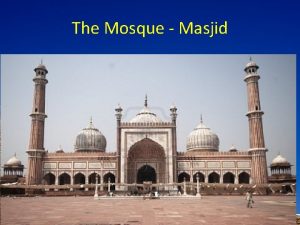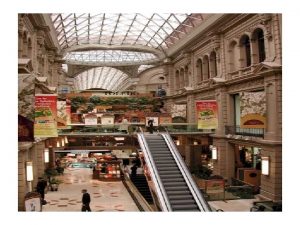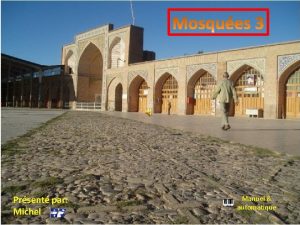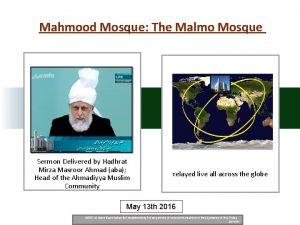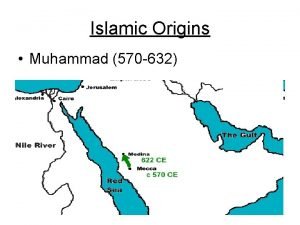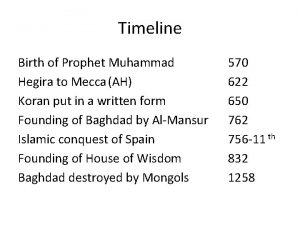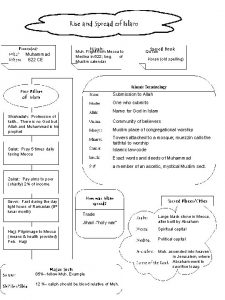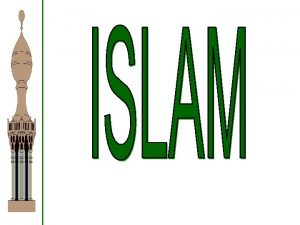ISLAM Medina mosque Mecca mosque Muhammad preaches to




























- Slides: 28

ISLAM Medina mosque Mecca mosque Muhammad preaches to early converts

Central Mosque Erin-Osun, Nigeria 2005

Mosques in Erin-Osun, Nigeria 2005 Imam’s home/mosque Mosque next to Iyaloja’s

Key terms Islam = “submission to the will of Allah (God)”; name of religion passed down from Allah to Muhammad Muslim = “one who submits”; one who practices the Islamic religion Qu’ran = “recitation”; Allah’s revelations to Muhammad for 23 years 114 chapters (surahs) 6, 000 verses (ayahs) Poetic, spiritual, moral teachings Pre-hijra revelations = belief in Allah’s spirituality Post-hijra = how to organize politically, economically, poor, disabled, crime, etc.

Muhammad ibn Abdullah Born in Mecca in Saudi Arabia (c. 570 – 632) Querysh ethnicity = nomadic traders who controlled Mecca politically & economically Khadijah = wife & 4 daughters 40 yrs. = Mt. Hira to fast & meditate, received revelations from Allah through Jibral, 1. Only 1 God, Allah, Muhammad is last prophet 2. Abraham founded the religious tradition, 1 st prophet 3. Jews & Christians strayed from their faith, M’s role was to restore faith for all people Next 23 yrs. = continued to receive revelations

Muhammad ibn Abdullah preached in Mecca New beliefs challenged Querysh religious beliefs & political/economic interests Querysh persecuted M so moved to Medina 622 = “Hijra”: emigration to Medina, 1 st year of Islamic calendar ruled as supreme judge & political leader of 1 st Islamic state & returned to control Mecca 632 = Mohammad died at age 72

Shia, Sunni, & Sufi Islam Who should become caliph upon M’s death? Ali, husband of Fatima: Shia Ali Abu Bakr, M’s disciple M selected Abu Bakr: Sunni Shia today: 10 -15% of Muslims Sunni today: 85 -90% of Muslims Sufism = mystical & ascetic spiritual practices, no Sharia, spiritual teachers have direct union w/Allah (shayks, pirs, walis, marabouts)

Stereotypes Orientalism = (Edward Said’s Orientalism, 1979); Western style of dominating, imagining, misrepresenting & having authority over the East Islam = inherently violent, called for holy wars to convert people Post 9/11/01 = backward religion, terrorists, violent fanatics who want to suppress freedom & dissent Reality = fastest growing of major religions: 1. 3 billion pple, 1/5 world population

5 Pillars of Islam 1. Shahada = profess faith in Allah & Muhammad 2. Salat = pray 5 times/day, facing Mecca 3. Sawam = fast during Ramadan (9 th month) 4. Zakat = give alms to support poor, orphans, disabled in your community 5. Hajj = make pilgrimage to Mecca (12 th month)

Aspects of Islam Cosmology = heaven, earth, hell Humans = represent God on earth, judged according to deeds Must follow God’s will, path of righteousness Weak & easily tempted, must repent “Islam” = submit to the will of Allah Day of reckoning = righteous to heaven, evil to hell Sharia = Islamic law: politics & codes for criminal law, family, marriage; different schools of Islamic law (Maliki, Hanifa, Al-Shafi, Hanbali)

Gender, family, marriage Early research: focused on texts, distorted realities, male researchers no access to women Qu’ran: forbids female infanticide & all sexual immorality Sharia law: Women inherit ½ parents’ estate Women are ½ legal status of men Polygyny practiced but not universally Arranged marriages: education, age, class, sex Economic, political, cultural factors influence practices: no rigid norms

The Veil

Pre-Islamic origins: Mesopotamian, Persian, Jewish, Christian, Byzantine cultures Hijab meanings Sacred divide between men & women Outward symbol of separation Modesty Morality Purdah = enforced seclusion of women Revival movements: women reclaim veil Protection from strangers Desexualizes work environment Anti-western colonialism & imperialism: attacked Islamic cultural identity

Islamic Civilizations Islam spread from Arabic region (Middle East) to: North Africa, Spain, and Asia Early civilizations: Baghdad (Iraq), Cairo (Egypt), Cordoba (Spain), Palermo (Sicily) Baghdad (750 – 1258) Universities Translated texts from Greek, Roman, Hindu, & Persian cultures into Arabic; synthetic philosophy Algebra, geometry, trigonometry, physics, astronomy, philosophy, art, architecture, medicine Arabic = (700 -1300, Middle Ages) world’s major intellectual & scientific language & influenced the West

Western colonization 1095 -1291 = “Crusades, ” EU launched military expeditions to defeat Islamic dynasties & return Holy Land to Christian rule EU wanted control of Eastern trade routes (spices, silk, cotton) 1400’s = Portuguese establish ports from Arabia to SE Asia, controlled spice trade 1800’s = EU colonizes Middle East: seeking raw materials & new markets

British & French colonies Suez canal: 1869, connected Mediterranean Sea W/Gulf of Suez 101 miles long immediate and dramatic effect on world trade combined w/ American Transcontinental railroad, allowed entire world to be circled in record time British & French owned increased EU penetration & colonization of Africa

Egypt: British colony in 1882; sugar, cotton Algeria, Tunisia, Morocco: French colonies; railroads, mining, agriculture Iran: N. Iran was Russian colony, S. Iran was British; tobacco SE Asia: Dutch in 1917; sugar, coffee, tobacco, indigo Malaysia: British; tin, rubber, Chinese labor

Post-WWII colonies French: North Africa, Lebanon, Syria British: Egypt, Iraq, Palestine, South Asia Dutch: SE Asia Colonial economies based on cash crops: tea, coffee, sugar, tobacco, cotton, opium Independence/nationalist movements, new nation-states in 1960’s: Algeria, Morocco, Egypt, Turkey, Iran, Indonesia, Malaysia, Kuwait, Iraq, Tunisia, Syria, Jordan

Post-colonial Islamic Reform movements Egypt Women are equal to men in constitution Anti-sexual discrimination laws Women involved in medicine, law, engineering, management, government, etc. Liberal divorce laws Turkey & Tunisia: prohibit polygyny Saudi Arabia Gender segregation: schools, jobs, transport, public entrances, etc.

Why Islamic resurgent movements in 1970’s? 1. 1967 Arab-Israeli war: Arab territories lost to Israel, turned to Islamic faith for strength 2. Oil boom: Allah’s will; revenues in Libya, Iran, Saudi supported fundamentalist movements 3. Disillusionment w/capitalism & socialism: looked to Islamic solution 4. Iran success: Islamic revolution overthrew secular, Westerninfluenced shah

Iran’s Islamic Revolution 1500’s: Shia Islam became state religion; today, 90% of Iranians are Shia leaders: Mullahs = village preachers Mujtahids = religious judges Ayatollahs = religious scholars, moral & political leaders Shahs = political rulers

Iran “modernizes” economy, military, education Educated elite: Western democratic values & representative govt. Opposed Shah’s absolute power Shia critique: shah gave West permission to undermine Islam 1925 -1979 Pahlavi dynasty Shia leaders viewed as obstacles to modernization Secular laws replaced Sharia law No more veil 1963 “White Revolution” Shah was “Great Satan, ” puppet of US govt. Commercial agriculture, land reform, capitalism, landless peasants, women vote, SAVAK secret police Ayatollah Khomeini arrested

Opposition increases 1. Rural migrants: sided with Islamic clergy 2. Westernized middle class: democratic hopes 3. University students: Shia Islam like liberation theology, free them from foreign control *Demonstrations, protests, fervor* 1979: Ayatollah Khomeini led revolution “Islamic Republic of Iran” = theocracy ruled by Shia clergy Political, cultural, social transformation

Islamic Republic of Iran Mosques = government offices, places of worship, local police; all Iranians forced to register Purge Iran of Western influences Women forced to wear head scarves Family Protection Act abolished Minimum marriage was 13, polygyny, divorce at will 10 year war against Iraq Struggle: moderate democrats v. conservative fundamentalists

Afghanistan 1800’s British supported leaders Modernization (built roads, etc. ) Unify/pacify ethnic groups 1920’s-30’s Economic development & democracy failed Soviet Union supported Marxist movements 1970’s Soviet Union sponsored 2 successful coups

Resistance forms Afghanistan ethnic groups: Pashtuns (47%), Tajiks, Uzbeks, Turkmen, Kirghiz, Hazara, Baluchis, Sunni (88%), Shia (12%) Mujahidin = “holy warriors” launched jihad (holy war) against Soviet-sponsored govt. 1979: Soviet Union invaded AF to repress resist. West gave financial & military aid to Mujahidin Afghans fled to Pakistan Soviets withdrew 1980’s-90’s Islamic & ethnic groups fought for power West w/drew support from Mujahidin, fearing revolution like Iran

Taliban emerges Taliban = “religious students” 1994 Islamic faction Afghan religious students recruited from schools in Pakistan Militia gained control over most of Afghanistan Strict Islamic guidelines & norms No music, dancing, singing, kite flying, cards, chess, etc Men can’t trim beards, women wear burqas Al Qaeda supports Taliban Headed by Osama Bin Laden = Saudi multimillionaire terrorist

Take-home messages 1. We must interpret multiple forms of Islam with respect to local cultural, historical, & political contexts 2. No essential “Islamic tradition” 3. Islamic fundamentalisms have emerged within the context of: Western colonialism, Western imperialism & internal factional, sectarian, and class differences
 If any man preach another jesus
If any man preach another jesus Sabah in arabic
Sabah in arabic Allahumma salli ala muhammad wa ala ali muhammad
Allahumma salli ala muhammad wa ala ali muhammad Who can go inside the kaaba
Who can go inside the kaaba Mecca is a city in ________.
Mecca is a city in ________. Brand image creative style
Brand image creative style Http //
Http // Mecca population
Mecca population Mecca lesson
Mecca lesson Which cultures believe in reincarnation
Which cultures believe in reincarnation Chapter 6 the world of islam answer key
Chapter 6 the world of islam answer key Akbar the great
Akbar the great Muhammad islam founder
Muhammad islam founder Sistem perundangan islam tasawwur
Sistem perundangan islam tasawwur Latar belakang kerajaan bani abbasiyah
Latar belakang kerajaan bani abbasiyah Kesimpulan tasawwur islam
Kesimpulan tasawwur islam Medina classification
Medina classification Poeta vicente medina murcia
Poeta vicente medina murcia Atlanta pancreatitis
Atlanta pancreatitis Separacion entre viguetas
Separacion entre viguetas Organigrama ipejal
Organigrama ipejal Generalidades del metabolismo
Generalidades del metabolismo El tomatero matute
El tomatero matute Emperador carlos medina del campo
Emperador carlos medina del campo Gustavo medina facebook
Gustavo medina facebook Indalecio medina
Indalecio medina Griselda quarta
Griselda quarta Mauricio lema medina
Mauricio lema medina Salomon aguilar medina
Salomon aguilar medina
